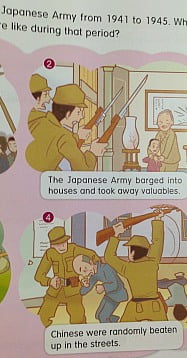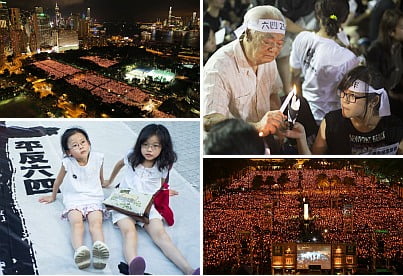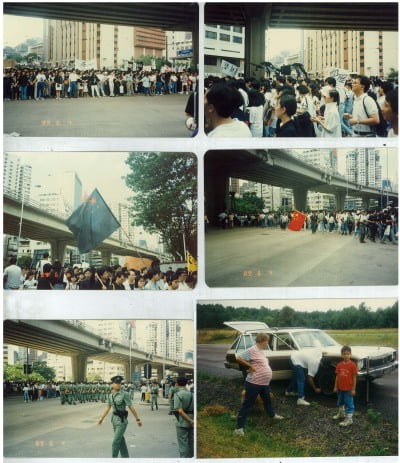Not for the first time, Hong Kong aces the World’s Most Photogenic Vigil contest with ease. Panoramas of a star-specked Victoria Park set among skyscrapers and harbour are all over the international media today, along with stirring close-ups of everyone, young and old, holding their candles and remembering. The imagery prompts more than a visual ‘wow’, especially when juxtaposed with the clampdowns and denial up in Beijing. This event does a hundred times more for the city’s global standing than a year’s worth of official speeches blathering about economic-freedom rankings and hubs and zones. Yet our leaders mysteriously vanish into some invisible place to silently cringe and wish it wasn’t happening. Another of those curious ‘contradictions’.
Better late than never (mislaid due to clunky file name), I dig up my own 25-year-old photos of the demonstration in Hong Kong on Sunday, June 4, 1989…
…(plus a free-no-extra-charge pic from that summer, in which a heavily pregnant cousin looks on as a blowout gets fixed on a crummy old station wagon still fondly remembered for having a bullet hole). The scene is just across from what was then the Xinhua News Agency (now the Cosmopolitan Hotel) in Happy Valley. There had been a massive march in support of the students a week or so earlier stretching from Central to past Tin Hau and back to Happy Valley. The mood this time was different, with disbelief and anger but also fear: there were rumours of tanks lining up in Shenzhen preparing to cross over the border, and the Canadian and other consulates were immediately swamped with visa applicants.
 Not exactly on a lighter note, but perhaps a weirder one – the perusing of those wacky textbooks continues. I suppose we should congratulate the education system for including Hong Kong History in the junior-school curriculum. Quite rightly, the book covers an earlier trauma for the city, namely the 1941-45 occupation. And it is also right that it mentions that the Japanese soldiers assaulted civilians. Except, it doesn’t say ‘civilians’ (or ‘ordinary people’ or whatever); it says ‘Chinese’. Which is obviously true, but sounds odd, given that most of the population was Chinese, and that Japanese soldiers would not have spared anyone else in the initial post-occupation raping and pillaging.
Not exactly on a lighter note, but perhaps a weirder one – the perusing of those wacky textbooks continues. I suppose we should congratulate the education system for including Hong Kong History in the junior-school curriculum. Quite rightly, the book covers an earlier trauma for the city, namely the 1941-45 occupation. And it is also right that it mentions that the Japanese soldiers assaulted civilians. Except, it doesn’t say ‘civilians’ (or ‘ordinary people’ or whatever); it says ‘Chinese’. Which is obviously true, but sounds odd, given that most of the population was Chinese, and that Japanese soldiers would not have spared anyone else in the initial post-occupation raping and pillaging.
Is this an extension of Beijing’s official ‘Chinese victimhood’ propaganda into Hong Kong classrooms? (Probably not, as the book covers the establishment of British colonial rule even-handedly.) Is it a conscious attempt to downplay the presence of non-Chinese in the city? (Unlikely, given other textbooks’ commemoration of all the resident happy smiling white ‘foreigners’ in suits and brown ‘foreigners’ in maids’ and construction workers’ attire.) Or is it another example of how the textbooks’ authors and publishers are living in the same insular, unworldly bubble that the Education Bureau says it wants to get kids out of? (Yes, presumably.)
Mercifully, the Victoria Park vigil forces the racist textbooks story out of the international media spotlight today.


